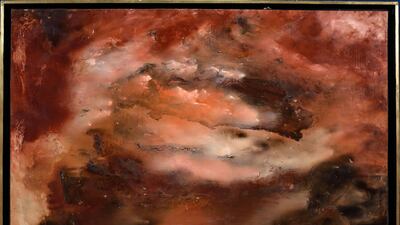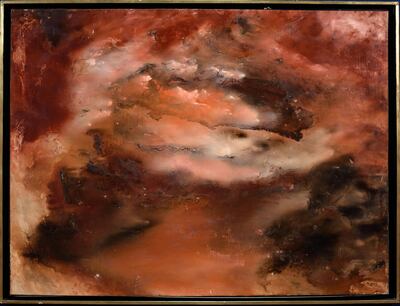In Suha Shoman's Chants Mystique, the eye is immediately drawn to the light at the centre of the painting. The edges are dark. The clay-hued clouds' shadows at the bottom are potent. The painting is wrought with cosmic tension. But the light in the middle alludes to a salvation. The clouds fold in such a way as if to direct the viewer's eye to that central beam, offering a path through the dense haze.
It is a cliche to compare paintings to windows. But the work – hanging on a blue wall at the far end of the Barjeel wing of Sharjah Art Museum – can be compared to little else. Even from a distance, it seems to look out to some mystical scene. You'll have to get really close to realise you're not looking through a pane of glass.
After 35 years, the work, which was considered lost, even by its own artist, is finally out in the public eye. And Shoman is glad that the painting has found its way back to the region.
Shoman, who was born in Jerusalem in 1944, tells The National that she last saw the painting when it was exhibited at the Wally Findlay Gallery in Paris in 1984, during her first solo exhibition. She was one of the first Middle Eastern artists to exhibit at the prestigious gallery in Paris. "I painted Chants Mystique in 1983. I wanted to capture the symbolic representations of light, which many artists have tried to achieve since the birth of Impressionism," Shoman says, adding that the painting is close to her heart.
That show was a turning point in the artist's career. Since then, her work has been exhibited all around the world, from Houston to Copenhagen to Tokyo to Ramallah. Shoman has also come to include video installations in her more recent work, which, like her paintings, explore issues of identity and memory.
But Chants Mystique had not always been on public display. It had been in the hands of a private collector for more than 30 years. It was art collector and researcher Sultan Sooud Al Qassemi who rediscovered the painting. Al Qassemi, who runs the Barjeel Art Foundation, had spent the better part of the year travelling across the Arab world looking in exhibition and auction catalogues for Modernist artworks by women from the region.
The mystery of 'Chants Mystique'
It had been a difficult task, especially with many of the works left undocumented by galleries and with no representation for many of the artists, he says.
"I came across Chants Mystique while trying to track down works by students of [Turkish-Jordanian artist] Fahrelnissa Zeid. I went through the list of artists who studied at the Fahrelnissa Zeid school in Amman, trying to find those who continued making art after they graduated. A contact in Jordan came forward with a low-resolution image of Shoman's painting. I was immediately interested."
Shoman was one of Zeid's students and in 1976, she studied under her instruction. Zeid was best known for her large-scale abstract paintings, many of which have dizzying kaleidoscopic patterns and blend elements of Islamic and Byzantine designs with influences of abstraction from the West. "Zeid was a pioneering Modern artist. She was part of the New School of Paris in the 1950s and 1960s and she taught lyrical abstraction, a style coined by critic Charles Estienne," Shoman says.
Between the late 1940s and 1950s, lyrical abstraction – or Tachisme – a French style of non-geometric painting, was popular. The movement's name, derived from the French word, tache, means stain or spot. The movement was developed as a response to early 20th century Cubism. Tachisme artworks often had splotches of colour, impulsive brushwork and calligraphy. Many parallels have been drawn between Tachisme and American Abstract Expressionism. But critics describe Tachist artworks as more subtle and raw than their American counterparts.
Early on in her career Shoman's paintings were more realistic. However, after studying under Zeid, the artist delved into lyrical abstraction. Chants Mystique represents the pinnacle of that approach, tackling light and its symbolic representations. The work was bought by an unnamed collector at the 1984 Wally Findlay Galleries exhibition in Paris. Since then, Shoman had heard nothing of its whereabouts.
'I thought it was lost for ever'
Through his research, Al Qassemi came across an image of the painting, but had little to no information about it. But things started to look up when he found a catalogue of the exhibition at Wally Findlay for sale on eBay. Chants Mystique was on the back cover. "The exhibition at Wally Findlay was a historic one," Al Qassemi explains. "Shoman was the first Arab woman to have a solo exhbition there, and the second artist from the Middle East. Lebanese abstract painter Wajih Nahle was the first. There were 12 of Shoman's works on display at that exhibition. They are all stellar works of art, but in my opinion, Chants Mystique is the most captivating."
With the help of George Al Ama, an art collector and researcher, Al Qassemi was able to broker a deal to buy the piece from its private owner. After being held at customs, the painting finally made its way to Sharjah Art Museum. "Every day felt like an eternity. I kept calling, making sure the painting was in the crate," Al Qassemi recalls.
Shoman is glad about its return. "I thought it was lost for ever. I am honoured that it is now on display at the Sharjah Art Museum. I'm glad that the painting found its way back home," she says.
"My only regret is that we didn't receive it sooner," Al Qassemi says. "We could have added it to our upcoming exhibition in New York."
That show is Barjeel Art Foundation's Taking Shape: Abstraction from the Arab World, 1950s to 1980s, which will open on Tuesday, January 14, at New York University's Grey Art Gallery in Manhattan. The show will feature nearly 90 works from the Barjeel Art Foundation's collection, presenting a diverse list of artists such as Etel Adnan, Samia Halaby, Dia Azzawi and Saloua Raouda Choucair. The exhibition will show in five US cities until 2021.
The opportunity for Chants Mystique to be shown in exhibitions across the US may have passed, but this is only the beginning for the newly rediscovered masterpiece. It still has plenty of time to shine for the world.
Chants Mystique is on show at Sharjah Art Museum until August



